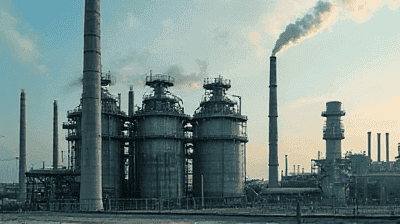
The production of steel and cement is essential to modern society, underpinning everything from infrastructure to construction. However, these industries are also among the largest contributors to global carbon dioxide emissions, accounting for approximately 8% of total emissions from steel manufacturing and around 7% from cement production. As the world intensifies its focus on climate change mitigation, the question arises: can steel and cement go green through carbon capture technologies?
Carbon capture and storage (CCS) is a suite of technologies designed to capture carbon dioxide emissions produced from industrial processes and store them securely to prevent their release into the atmosphere. CCS involves three primary steps:
Capture: CO2 is captured from the flue gases generated during industrial processes before it can escape into the atmosphere.
Transport: Once captured, the CO2 is transported to a storage site, typically via pipelines, where it can be securely stored.
Storage: The CO2 is injected into geological formations deep underground, where it can remain stored for thousands of years.
CCS has been recognized as a critical technology for achieving global climate targets, particularly in industries that are inherently carbon-intensive, such as steel and cement manufacturing.
Heavy industry, including sectors like steel and cement production, faces significant challenges in reducing carbon emissions due to the chemical processes involved and the high energy demands of these operations. Implementing CCS can help mitigate the environmental impact of these industries by:
Reducing Overall Emissions: CCS can significantly lower the carbon footprint of steel and cement production, helping to meet national and international emissions reduction targets.
Enabling Transition to Low-Carbon Technologies: CCS can serve as a bridge technology, allowing existing facilities to adapt while newer, greener technologies are developed and implemented.
Facilitating Resource Efficiency: By capturing CO2 emissions and potentially reusing them in other processes, CCS encourages greater resource efficiency within the industry.

The successful implementation of CCS in heavy industries requires understanding the various carbon capture technologies and their applicability to the steel and cement sectors.
Post-combustion capture involves removing CO2 from the gases emitted after fossil fuels are burned. This method can be effectively applied in many existing steel and cement plants.
Amine-Based Absorption: One common post-combustion method is amine-based absorption, where CO2 is absorbed in a solution containing amines, which then react with the CO2.
Advantages: This technology can be retrofitted to existing plants, making it relatively easy to implement.
Drawbacks: The process can be energy-intensive and requires significant amounts of solvent, leading to concerns about lifecycle costs and environmental impacts.
Pre-combustion capture involves converting fossil fuels into hydrogen and CO2 before combustion, enabling easier CO2 removal.
Gasification: In this method, fossil fuels are converted into syngas, which comprises hydrogen and CO2. The CO2 is then separated before combustion.
Advantages: Pre-combustion capture has higher efficiency in CO2 removal compared to post-combustion methods and can supply hydrogen for various applications.
Drawbacks: This method typically requires substantial modifications to existing plants and infrastructure.
Oxy-fuel combustion uses pure oxygen instead of air for combustion, resulting in flue gases that are primarily CO2 and water vapor, making CO2 capture easier.
Process Overview: The separation of oxygen from air can be achieved using cryogenic distillation or membrane separation technologies.
Advantages: Oxy-fuel combustion yields a concentrated CO2 stream, simplifying the capture process and potentially increasing the overall efficiency of the combustion process.
Drawbacks: This technology requires significant upfront investment and modifications to existing equipment.
Direct air capture (DAC) involves removing CO2 directly from the atmosphere, offering a potential solution for offsetting emissions from sectors that are difficult to decarbonize.
Technological Approaches: Various methods are being developed, including chemical processes that absorb CO2 from the air and filter systems.
Advantages: DAC can be situated near heavy industrial plants to handle emissions that are otherwise challenging to capture.
Drawbacks: Current DAC technologies are still in the early stages of development, facing high costs and energy demands.
The steel industry is among the most energy-intensive sectors, primarily relying on fossil fuels for production via processes such as the blast furnace method. The integration of carbon capture can transform the industry's environmental impact.
Several steel manufacturers have initiated pilot projects and full-scale implementations of CCS technologies:
The H2H project in the UK: A proposed hydrogen production project aims to replace fossil fuels in steelmaking while capturing CO2 emissions.
The Salzgitter AG project in Germany: This initiative focuses on capturing and using CO2 emissions as feedstock for new products.
The CarbFix project in Iceland: This project captures CO2 from the air and injects it into geological formations, where it reacts with basalt rock to form stable carbonates.
Despite promising advancements, the steel industry faces several hurdles in adopting carbon capture technologies:
High Costs: Implementing CCS requires substantial investments in new technologies and infrastructure.
Energy Requirements: The processes involved in capturing and compressing CO2 consume significant energy, potentially negating some emissions reductions.
Regulatory Framework: Inconsistent policies related to carbon emissions and capture can create uncertainty for industry stakeholders.

The cement industry, characterized by the calcination process that generates CO2 as a by-product, presents its own unique challenges for carbon capture.
The production of cement involves heating limestone (calcium carbonate) to produce lime (calcium oxide) and carbon dioxide. This process accounts for approximately half of the emissions generated during cement production.
Several initiatives are underway to integrate carbon capture in cement manufacturing:
LafargeHolcim’s CarbonCapture project in Switzerland: The company has been exploring ways to capture CO2 from its cement plants and has initiated pilot studies to test various capture technologies.
CCS Innovation in Norway: The Norcem cement plant in Brevik is testing carbon capture technologies to significantly reduce its emissions.
The cement industry faces specific challenges related to CCS implementation:
Nature of Emissions: The inherent production of CO2 during the calcination process complicates efforts to achieve net-zero emissions.
Lack of Alternatives: Unlike steel, where alternative production methods (like hydrogen-based processes) are being explored, cement production has fewer feasible alternatives without carbon emissions.
Market Dynamics: The competitiveness of cement products and pricing pressures can hinder the immediate adoption of additional costs associated with carbon capture.
Implementing carbon capture in the steel and cement sectors presents numerous benefits that extend beyond simply reducing greenhouse gas emissions.
The primary benefit of CCS is the potential for significant carbon emissions reductions. Implementing these technologies can move the steel and cement industries closer to their climate targets, contributing to overall global efforts to mitigate climate change.
Investing in CCS technologies can create new jobs in engineering, manufacturing, and construction, as well as driving research and development in environmental technologies.
CCS technologies inherently push industries to optimize their processes. This promotes greater energy efficiency and can lead to operational savings in the long run.
Companies that invest in CCS demonstrate a commitment to sustainability and environmental responsibility, improving their public image and competitiveness.
As global regulations on carbon emissions tighten, industries that adopt innovative solutions like CCS will be more adaptable to changing market conditions and ensure long-term viability.

As the world transitions toward a sustainable future, the role of carbon capture technologies in steel and cement production is becoming increasingly vital. Several trends are expected to shape the future landscape of CCS in these industries:
Public and private stakeholders are expected to collaborate more closely to research, develop, and implement carbon capture technologies. This includes partnerships between industry players, research institutions, and government agencies.
Governments may create supportive policy frameworks and incentives that encourage investments in CCS technologies, helping to lower barriers for adoption and enhancing economic feasibility.
Continuous advancements in carbon capture technologies are anticipated, improving efficiency and reducing costs. Innovations in materials and processes can enhance the commercial viability of CCS.
As environmental awareness grows among consumers and businesses, the demand for sustainable practices is expected to influence steel and cement manufacturers to adopt carbon capture technologies.
The integration of carbon capture with circular economy principles will gather momentum, encouraging industries to find new ways to make use of captured CO2 as a resource for creating new products, such as chemicals and fuels.
The potential for carbon capture technologies to transform the steel and cement industries is immense. While challenges remain, the combination of growing environmental awareness, supportive policies, and technological advancements point towards a future where steel and cement production can align more closely with sustainability goals.
By embracing carbon capture and related innovations, these vital industries can significantly reduce their carbon footprint while maintaining their essential role in the global economy. As we strive for a greener future, the journey towards making steel and cement greener through carbon capture will be an essential component of achieving lasting environmental progress.